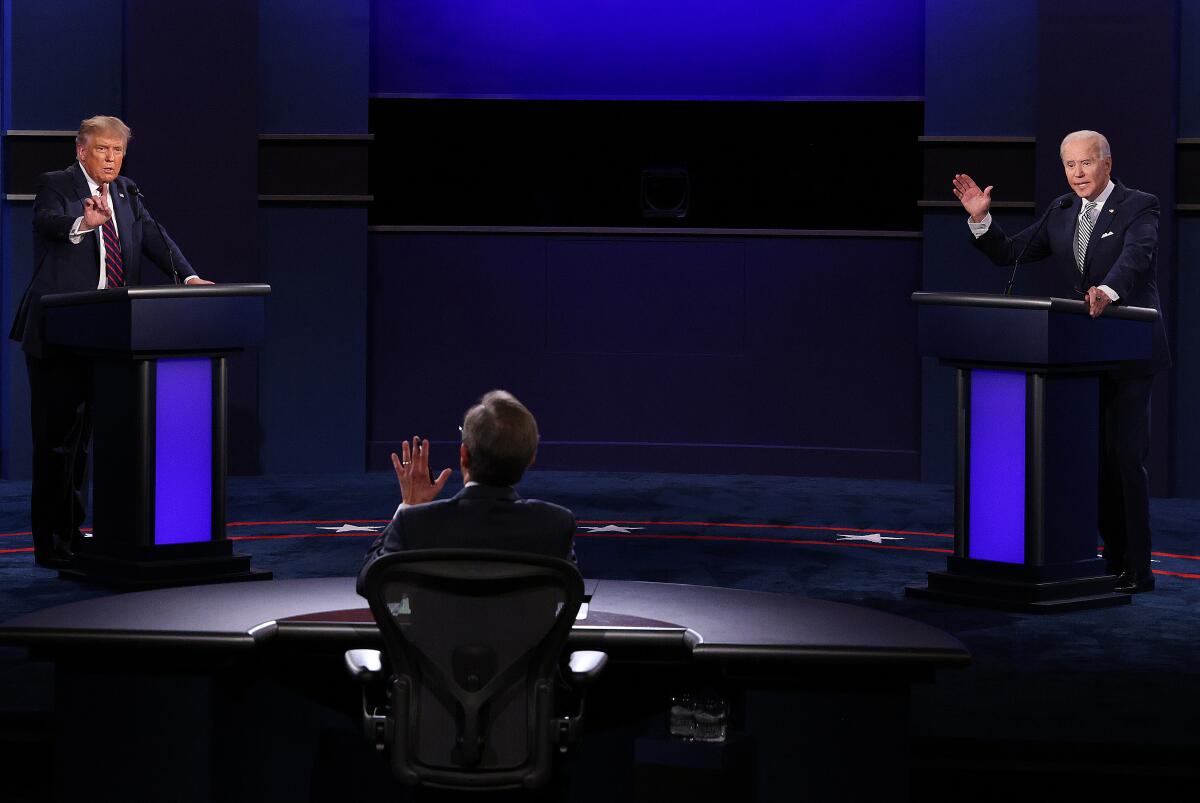Op-Ed: The trouble with counting interruptions in a debate

- Share via
Interruptions are at the heart of the announcement by the Commission on Presidential Debates that during the Trump-Biden debate Thursday night each candidate’s mic will be muted during the other’s initial answer to the moderator’s questions. This is a necessary attempt to enforce the agreed-upon rule that the six debate segments begin with each candidate addressing the topic in two minutes uninterrupted.
The commission has also declared that “time taken up during any interruptions will be returned to the other candidate.” This, too, is necessary, but far less simple. Not all interruptions are created equal, and not all interruptions are interruptions — in debates or in everyday conversation.
In my linguistic research, I have found that many verbal moves people label as interruptions really aren’t. When we say someone was interrupted, we are interpreting the action — and judging it. The term claims that the second speaker stole the floor from the first, who rightfully owned it.
What President Trump did at the first debate with Joe Biden was far worse. To be interrupted, a speaker has to have the floor; Trump’s nonstop barrage prevented Biden from ever holding the floor in the first place.
It was probably with Trump’s onslaught in mind that much of the commentary on the debate between Kamala Harris and Mike Pence also focused on interruptions. CBS counted 10 interruptions by Pence and five by Harris while NBC News tallied 16 for him and nine for her.
The difference in these numbers shows that it’s rarely self-evident when an interruption has occurred. What if a candidate inserts a quick comment but is not trying to take the floor? For example, when Pence said that Harris and Biden would abolish fracking, Harris said “That’s not true” — and stopped there. This wasn’t an interruption but an interjection.
Many commentators viewed Pence’s greater number of interruptions in the context of the candidates’ genders. Abundant research has shown that men tend to interrupt women more often than the reverse, even on the Supreme Court. A study by Tonja Jacobi and Dylan Schweers found that male justices interrupt their female colleagues more often than they interrupt one another — and also, astonishingly, that advocates arguing cases before the court often interrupt female justices, despite rules forbidding it.
Given these well-documented patterns, it might seem surprising that in a study of women and men talking at work, I found that women-only meetings and conversations had more instances of two voices going at once than men-only meetings and conversations.
Yet, much of the women’s overlapping talk was designed not to steal the floor but to show understanding of others’ points or enthusiasm for them. Talking along to show enthusiasm and active participation — what I call “cooperative overlap” — can vary by culture or geography as well as gender.
In another study, I found that New Yorkers often talked along to show interest and enthusiasm. When this happened among New Yorkers, the speaker did not stop. Californians, however, often concluded that a cooperative overlapper was trying to take floor — and stopped talking, thereby creating an unintended interruption.
Even if speakers are, in fact, trying to take the floor before another is ready to yield it, they aren’t always violating norms. For some speakers in some contexts, repeated interruptions show that both speakers take the conversation seriously, are invested in their opinions, and trust that interruptions will be mutual and equally distributed. Both are implying: “I know where you’re going and can’t wait to chime in; when you know where I’m headed and feel equally strongly, you’ll do the same.” This approach only becomes a problem when used with someone who doesn’t share that style, so the interruptions are all on one side.
For these reasons, not every instance where someone starts talking before someone else stops is an interruption. It might be something better, or something worse. I know from my research on casual conversation among friends as well as on workplace interaction that someone who talks along might be intending to encourage rather than silence someone else. Or, as we saw with Trump’s behavior in the last debate, what’s been called interruption was really a verbal assault.
I hope that any analysis after Thursday’s debate does not overapply the term “interruption.” Overly broad use of that word may downplay the destructiveness of what really is verbal obstructionism and give a bad name to the many types of non-interruptive interruptions that can be constructive in everyday conversation.
Deborah Tannen is university professor and professor of linguistics at Georgetown University. Her books include “You Just Don’t Understand,” and the memoir “Finding My Father: His Century-Long Journey from WWI Warsaw and My Quest to Follow.”
More to Read
A cure for the common opinion
Get thought-provoking perspectives with our weekly newsletter.
You may occasionally receive promotional content from the Los Angeles Times.










